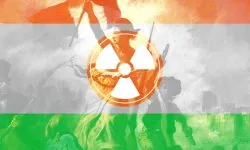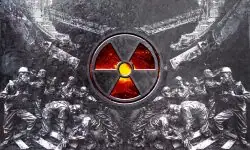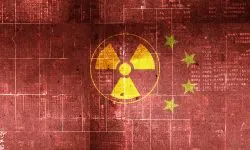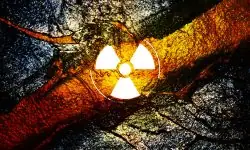(Art direction: Jean-Dominique Lavoix-Carli)
How can we create new civilizations adapted to the challenges of the present and of the future? Can we do it despite tremendous pressures such as climate change, or blows such as defeat at war?
- Niger: a New Severe Threat for the Future of France’s Nuclear Energy?

- Revisiting Uranium Supply Security (1)

- The Future of Uranium Demand – China’s Surge

- Uranium and the Renewal of Nuclear Energy

- AI at War (1) – Ukraine

In this series of articles, we use Toynbee’s masterful A Study of History to explore the fate of civilizations and, more specifically, to understand what could happen to our 21st century civilizations (Arnold Toynbee, A Study of History, Oxford University Press, 1934 [tomes 1-3], 1939 [tomes 4-6], 1954 [tomes 7-10], 1959 [tome 11], 1961 [tome 12] – page references in the body of the text are to the abridged version we used: D. C. Somervell, A Study of History: Abridgement of Vols I-VI, with a preface by Toynbee, Oxford University Press 1946).
Following on our previous article, we focus here on the second factor that is necessary to make a society truly dynamic again and create a new civilization.
As seen, the challenges and pressures a society faces are the first factor necessary to create a new thriving civilization.These challenges, however, must have an intensity that is neither too weak nor too severe but in the “golden mean”.
As a result, facing pressures such as climate change or defeat at war may also become the beginning for something new. Indeed, once a civilization is faced with pressure, a stimulus is created that will generate a response.
This article focuses on the response to challenges and its process. Only if the answer is adequate will the process of generating a new or adequately renewed civilization be successful. If not, the society will remain petrified and disappear in the long term or, alternatively, succumb rapidly.
There can be only one
Toynbee stresses three different ways a society may choose to answer the key challenges and pressures it faces, each with different outcomes.
First comes the least favorable result. If, when faced with a civilizational challenge, a society refuses or is incapable to change anything to its way of life, habitat, organisation, economy, values, etc., then extinction follows (p.69).
Second, comes a range of average outcomes. If a society changes a series of factors mainly to avoid changing one factor it deems as key, then a series of various fates, more or less dynamic and interesting may evolve (pp. 69-70). However, none of them is optimum and leads to a higher and better adapted civilization (Ibid.).
Finally, Toynbee outlines the best possible result. If a society accepts to change everything, from its way of life through its economy to its values, creatively, in order to overcome the new challenge and adapt to the new conditions, then it evolves into something more advanced and superior (p. 70).
In this best case, then there is a supplementary condition that must be met. The various comprehensive changes the society carries out must be done in a way that does not spend all the energy of the said society. Indeed, should the efforts that lead to change exhaust the society’s energy, then the price to pay would be the creation of a new yet aborted civilization (pp. 164-186; 574-575).
Real and false growth
More generally, Toynbee defines what is a proper answer to challenges and pressures so that the response leads to civilisational growth.(1) Then he uses this approach to single out two types of responses that are commonly believed to bring growth, but actually lead only to “false growth”.
Real growth
According to Toynbee, the proper answer to challenge and pressure that leads to real growth takes place when, through the “overcoming of the material obstacle”, a society releases its energy “to make responses to challenges which henceforth are internal rather than external, spiritual rather than material” (p.576). The author names this process “etherialization”.
In other words, the successful response does not only imply overcoming an external challenge but also demands a shift in energy towards transforming one’s society into something better adapted to the challenge. It implies a displacement of energy from one area that is external, to another that is internal (pp. 198-199).
For example, at the end of the first millenium, in Europe, overcoming the Viking onslaught could take place, among others, thanks to the creation of the feudal system (p. 202). Meanwhile a complex system involving spiritual and secular powers and relationships evolved, for instance, with the creation and development of castles (castrum) and advowson (advocatus) (Brigitte Meijns, “Les premières collégiales des comtes de Flandre, leurs reliques et les conséquences des invasions normandes (IXe-Xe siècles)“, Revue belge de Philologie et d’Histoire, Année 2007 85-3-4 pp. 539-575). Hence, an external threat the Viking attacks – was not met only through external means, such as military defense. Actually, the external threat was answered by an internal response, the political and religious organisation of society.
As an illustration for the 21st century, let us take the example of the hyper industrial and consumer society faced with climate change. We may recall that our era is also now known as the anthropocene. This very name highlights that “Our new geological period is … defined as being “anthropos” (meaning “human”) driven, because humankind has become the major geological and biological force on Earth” (for a detailed explanation of the anthropocene, Jean-Michel Valantin, “The Anthropocene Era and Economic (in)Security – (1)“, RTAS, 19 September 2016). Hence, this implies that human societies – or rather the majority of scientists as well as concerned people – have started understanding that climate change is not something external to 21st century human civilizations, but internal to them. We have thus come part of the way, if we do not want our civilizations to break down but, wish, on the contrary to see renewal and real growth in the wake of this immense challenge.
Having the proper understanding, in Toynbee’s perspective, we can now create the proper answer. The response that must be given, and that is indeed imperatively demanded of all civilizations is internal: reduce GHG emissions (e.g. see all the IPCC reports). If Toynbee is correct, then it is highly likely that reducing GHG emissions will be and need to be part of far ranging changes and shifts, involving all components of our civilizations, as seen above.
As a civilization ages and grows, then challenges must increasingly be handled internally. This is also the case even if a new civilization has to be created by secession to face pressures, leaving behind the part of civilization that does not want to change and is thus doomed to fail.
False growth
Real growth, thus, does NOT take place when a civilization only develops an increasing control over the external environment. The two cases Toynbee studies are first conquest and military attacks (notably pp. 189-192), and second technical innovation (pp. 192-197). Using various counter-examples from various civilizations, he shows that neither one nor the other leads to a higher and better civilization. For him, limiting a response to these two aspects is inadequate.
Considering 21st century beliefs in the virtue of technical innovation and thus how counter-intuitive Toynbee’s findings are, we highlight now why the author stresses that technical innovation does not lead to real growth for a civilization.(2)
Using historical cases, Toynbee shows that some civilizations have known periods of continuing technical innovation in some areas, while the corresponding civilization was not growing. For example, in Hellenic society, a century of war “from the outbreak of the Atheno-Peloponnesian war to the Macedonian victory …(421-338 B.C.)” had as outcome an improvement in the technique of war while the Hellenic civilization also broke down (pp. 194-195).
Similarly, always in the case of the Hellenic or Graeco-Roman civilization, the author stresses that the technique of agriculture improved as decline gathered speed. For example, in Attica, approximatively during the late 7th to 6th century B.C., the transformation from mixed farming to specialised agriculture for exports was first followed by a boost of energy that could make believe that the response was adequate. Yet, the next stage, which was the development of mass production through slave labour, brought about so many negative social and moral consequences over four centuries it contributed, according to the author to the “general social débâcle of the third century after Christ” (pp. 195-196).
As Toynbee showed with counter-examples that technical innovation alone led to growth that could also be correlated or even contribute to decline and break-down, then it implies that the growth deriving from technical innovation alone is not real in the sense that it does not lead to a better, higher and more evolved civilization.
Notably for the tech savvy 21st century civilizations, Toynbee’s findings on technical developments are key.
Indeed, 21st societies tend to believe that technology is a universal saviour, and that no effort other than technological innovation is required. For example, for some people, carbon sequestration and elimination along various high tech devices of geo-engineering still to be created or manufactured are meant to be THE solution to climate change. Yet, if we follow Toynbee, whatever the importance of solutions such as carbon elimination, which must indeed be endeavoured, it is certain that only trying to find technical solutions to climate change will not allow us to use the pressure of climate change to grow and develop a better civilization. This finds an illustration in the report “How to avoid carbon removal delaying emissions reductions” (Carbon Gap, 27 September 2023), as both emissions’ reductions, which will necessitate many fundamental changes, and carbon removal are necessary (e.g. Nathalie Mayer, “Nous n’arriverons pas à éliminer les 10 milliards de tonnes de CO2 par an annoncés pour 2050“, 7 October 2023). Carbon removal’s technical innovation alone will not be enough.
Following Toynbee, if we decided to count only on technical innovation to answer the challenge of climate change then we could focus on an inadequate answer for a very real pressure. As a result, such a response could contribute to see the 21st century civilizations break down.
On the contrary, a response designed to include creative internal changes, as we saw previously, as well as, why not, technical innovation, could be the adequate way forward.
Now we have seen that multi-dimensional changes to our 21st century civilizations are necessary and that these must involve primarily internal changes, thus fundamentally novel ways and values, how can we imagine and create these changes? How can we design such a response to the many challenges we face?
Responding to Pressures: a two stages process
1st stage – Creation and the creative group
“The responsibility of a few”
For growth to happen, to answer challenges and pressures, thus, a society needs to see truly creative ideas, taking into account all factors and elements constituting both the challenges and the society.
Building notably upon the philosopher Bergson (Les Deux Sources de la Morale et de la Religion), the author insists that the creative process is “the responsibility of a few”, who are sole able to carry out this process. Not to succumb to their genius notably because of rejection and incomprehension, the creators will need, later on, to teach the new ways to the “uncreative masses” (pp. 209-216).
For the stage of creation, imagination and design, creative individuals (pp. 217-230) and creative groups (pp.230-241) need to withdraw from society to carry out the necessary creative process. Sometimes this withdrawal may be forced upon them (ibid.). Withdrawal is necessary to be away from distractions and social obligations (ibid.).
As examples of creative individuals, Toynbee refers to what he calls “great pioneers”, such as “Saint Paul, Saint Benedict, Saint Gregory the Great, The Buddha, Muhammad, Machiavelli, Dante” (pp. 217-230).
As far as creative groups are concerned, Toynbee refers to sub-societies, “constituent parts of societies”. He gives among other examples Italy “in the second chapter of the growth of Western Society”. Then, between the middle of the 13th century and the end of the 15th, Italy withdrew from the “tumultuous feudal” strife, which allowed for the development of the intensive and “greatest achievements of the Italian genius” across all arts, which then could spread (pp 231-233). Another example is Athens during the second period of growth of the Hellenic Society. Athens had to overcome the challenge of over-population in the 8th century B.C. and created an original solution over two centuries, which led to a new more vibrant, influential and involved role, starting in the 5th century B.C. (pp. 230-231).
We deduce from Toynbee’s examples that the “creative group” may be different entities, of different size, with different characteristics. It needs, however, to be organised – even informally – enough to then allow for the next stage of the process to happen.
We also have to consider, however difficult it maybe for our 21st century thinking, that the creative processes Toynbee addresses were long, and lasted a couple of centuries. This question of time, considering the urgency of the challenges the 21st century civilisations face on the one hand, the perceived acceleration of time, on the other, deserves further reflection and research.
The uncreative power of the dominant group
Even though we have past historical examples showing the success of creation in answer to civilizational challenges, there is actually no fortunate fatality in seeing a creative individual or group succeed when facing such pressures. If creative individuals and groups fail to find the adequate creative response to the challenges faced, then the civilization will succumb (pp.214-243, 245).
If ever the creative group were to lack proper creative power and be unable to design a truly creative and adequate answer, then what was initially the creative group would become a mere “dominant” group (p.246).
Using history as previously, Toynbee explains that, most often, the creative group that successfully solved past challenges is rarely the one that will solve the next ones (pp. 307-317). It thus becomes a dominating group and not a creative one, which leads to the break-down of a civilization.
It is thus key, considering the number of challenges and pressures the 21st century faces (see article 1), that true creativity be fostered in our civilizations, however difficult this may be. Without being pessimistic, we may wonder, however, if dominating groups truly can, considering the numbers and intensity of the interests at hand, allow others to develop creative solutions, and later to spread them (see Helene Lavoix, The Chronicles of Everstate – “2212 EVT: Ideological Stakes in an Outdated Worldview” and “2212 EVT: Material Stakes in an Outdated Worldview“, RTAS, February 2012).
In terms of geopolitics and international relations, Toynbee’s argument implies that the U.S., having been the architect of the Pax Americana and of the Washington consensus, and the leading power of the last forty years or so, is very likely not to be the “creative group” that will renew the world civilizations as they are confronted to the challenges of the 21st century. The U.S. have indeed not taken the lead in answering the challenge of climate change. For example, if we consider we want to limit warming to 1.5°C – assuming American emission have remained flat compared with 2019 – 2024 is the year when the U.S. carbon budget runs out (e.g. Helene Lavoix, “Climate Breakdown: Towards War to Reduce CO2 Emissions?“, RTAS, 19 September 2023). Moreover, recent international events highlight a loss of influence that tends to constantly impacts American actions, not only in Asia but also in the Middle East (e.g. Jean-Michel Valantin, “The war in Gaza and China’s pivot to the Middle East” and “From the War in Gaza to the Great U.S.-China War (2)?“, RTAS, 22 Nov and 26 Dec 2023), to say nothing of the expansion of regional bodies such as BRICS into BRICS+ (BRICS+, “Brics to add Argentina, Egypt, Ethiopia, Iran, Saudi Arabia and UAE as new members“, 24 August 2023). These signals of an American loss of influence would tend to stress that, if the U.S. has been a creative body in the past, the third decade of the 21st century shows strengthening evidence that America is increasingly becoming merely a dominant group. We may thus expect rebellion and secession away from its civilization.
Without hindsight, it is of course harder to identify which individuals or groups are truly creative considering the 21st century challenges. It may be that they are still in the withdrawal phase and that we cannot see them. It could be that the couple China-Russia, as the U.S. fears, will be the creative group that will answer adequately the current challenges (Helene Lavoix, “The American National Interest“, RTAS, 22 June 22). However, the Sino-Russian management of the challenges of climate change does not suggest that these two countries are the obvious creative group for the future either (Helene Lavoix, “Climate Breakdown). Likely, the creative group or groups, considering the breadth of change that must be accomplished, will be entities that are not or not only modern states. A comprehensive strategic foresight exercise should be carried out on this theme.
2nd stage: mimesis
Assuming true and adequate creation has taken place in response to pressures and challenges, then the creative individuals and the creative group, must return to society to diffuse their creation (pp. 209-241).
They must make sure that the “uncreative majority” follows their lead and “breaks the cake of customs” (an expression Toynbee borrowed from Walter Bagehot(3) – pp. 214-216).
According to Toynbee, it is through mimesis, i.e. imitation, a “generic feature of social life”, that the “uncreative majority” comes to adopt the creative novel response (p.216). Examples of mimesis are fan-like behaviour, following the herd mentality, influencers and their followers, as well as automatic admiration for signs of status, attempts at acquiring such signs and reproduction of behaviour.(4) Mimesis is necessary because the creative group must not only spread entirely new – and adequate – ideas, but also real changes in values, ways of life and behaviour, sometimes in very practical, day to day, matters.
Toynbee’s succinctly describes the way mimesis takes place:
“In order to draw the inert majority along in the active minority’s train, the ideal method of direct individual inspiration has always had to be reinforced by the practical method of wholesale social drill [mimesis] – a habitual exercise of primitive mankind, which can be made to serve the cause of social progress when new leaders take command and issue new marching orders.
Mimesis may lead to the acquisition of ‘social assets’ – aptitudes or emotions or ideas – which the acquisitors had not originated and which they would never have possessed if they had not encountered and imitated those who possessed them.”
Somervell, A Study of History… p.216.
From these paragraphs we can deduce two points.
First, the creative group can trigger mimesis only from a place where it leads followers. This implies that the withdrawal the creative group operates to create does not mean an exit from society, but only a temporary retreat. The creative group likely finds back at least a modicum amount of power and status when it fully returns to life in society. Then, to become a leading group, the creative group will have to contend with other groups, which means power struggle as well as mobilization of followers, which Toynbee glosses over, but must not be forgotten.
Second, Toynbee’s argument begs a question. Why would the masses or part of them choose the novel ideas and ways over the old ones, as for both the same process, mimesis takes place. Part of the answer may be related to the new social assets that those using mimesis acquire, and that they would not have obtained without imitation. This may lead them to choose new ideas and ways over old ones, for example if old behaviour and past mimesis had not allowed them to acquire enough assets, and if they see an interest – including in meeting their needs – in acquiring the new assets.
Hence, mimesis, even if it is the only process possible to see the creative response widely adopted, appears nonetheless as fraught with uncertainty. The creative group must be able to foster mimesis and the majority must see an interest in changing the object of its mimesis.
Then, as mimesis takes place, Toynbee highlights various reactions that can be triggered that will impact both the mimetic process and the future of the civilizations as they face challenges and pressures (pp.279-307). Indeed, as we earlier wondered if existing interests groups would allow creativity and its early diffusion, we may similarly wonder how these interests would react to spreading mimetic changes related to a truly creative answer to challenges and pressure.
When the new creative elements of the response are introduced in society, new social forces, constituted according to the author by emotions, aptitudes and ideas, are unleashed (p. 279). However, the existing institutions of society, built in the past, are not made to handle these new forces. Henceforth disharmony and tension occur.
Ideally, new institutions should be built for the new ways. But this is only an ideal which is impossible in reality (Ibid.).
The best case happens when the new ways are carried out throughout society through new adapted institutions co-existing with old institutions, while the latter evolve and adjust harmoniously to novelty. In that case, a new stage of growth for the existing civilization or a new civilization, able to face the challenges and pressures at hand, emerges. Toynbee calls this case “adjustment“.
Alternatively the old institutions may be unable to handle the new ways through adjustment and block them. We then have two possibilities.
First, the old institutions finally break down. This is what Toynbee calls a “revolution”. In this case, we must face “retarded and proportionally violent acts of mimesis” (p.280). Indeed, the mimetic process for the adoption of new ways is thwarted by the old institutions. This means a delay, and as the delay lengthens, power builds up, until the old institutions cannot contain anymore the new, which erupts with violence. The obvious example chosen by Toynbee is the French Revolution of 1789, inspired by both the American Revolution and two generations of “glorification” of English achievements in France through the enlightenment (p. 280-281).
Second, the old institutions do not break down but successfully thwart the new ways. Toynbee calls such a case an “enormity”. It is equivalent to a “frustrated mimesis” (p.281). This leads to the break-down of society and civilization.
In any given society the three “adjustment, revolution and enormity” may coexist in different sectors. If harmonious “adjustment” prevails then civilization renews itself. If revolutions prevail, growth and thus survival of the civilization will “become increasingly hazardous”. If “enormity” prevails, then civilization breaks down (p. 281).
However tragic some of these futures may be, Toynbee also offers us some supplementary glimmers of hope. He explains that one may secede from a civilization heading towards its fall. We shall address the creation of a new civilization through secession in another article.
Notes
(1) Toynbee mainly describes the process of response for the stage of growth after the birth of a new civilization. However, we assume here that the process described for growth is similar to the process necessary for the creation of a new civilization. Furthermore, the insights of the author are so interesting and at times so surprising it would be wrong not to present them.
(2) On a related yet distinct topic, that nevertheless reinforces Toynbee’s argument, Daron Acemoglu and Simon Johnson highlight that technology alone does not bring progress; it is a tool that must be “brought under control” to obtain governing objectives such as democracy, empowerment for people or widespread prosperity, Power and Progress: Our Thousand-Year Struggle Over Technology and Prosperity, (MIT Press, 2023).
(3) Walter Bagehot, Physics and Politics, 1872: see, for example Calvet Henri, “Un économiste victorien : Walter Bagehot“, In: Revue d’histoire moderne et contemporaine, tome 3 N°2, Avril-juin 1956. pp. 156-163.
(4), It would be interesting to consider René Girard’s mimetic theory of desire in the light of Toynbee’s work.





